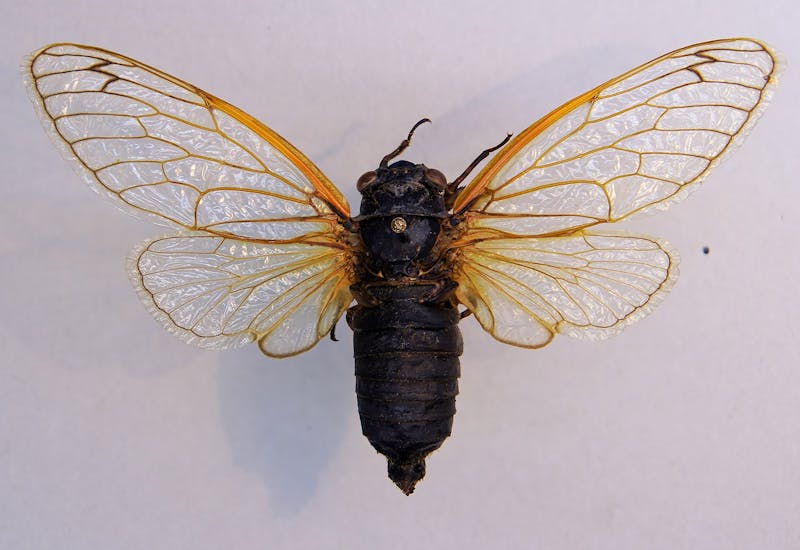TL;DR Science: Periodical Cicadas
By Thomas P.
June 02, 2021 · 3 minute read
Earth Science
Environmental Science
Biology
This year, a species of the periodical cicada known as Brood-X will hatch. Brood-X, which roughly translates to 'family-10', is the largest brood of any kind of cicada. This event, when Brood X cicadas appear in the north every 17 years is a celebrated event by scientists as well as people.
What are Periodical Cicadas?
Also known as 17-year locusts (though NOT locusts at all), periodical cicadas are a type of insect that looks much like the following. As is evident, they are somewhat hard to describe except in that they have thick brown bodies and four wings:

(Picture above: the cicada that is most often seen, and the type species of periodical cicadas: Magicicada septendecim. Source: Wikimedia Commons.)
Periodical Cicadas appear from the ground, where they spend most of their life as nymphs, to develop into adults at 17-year intervals since they were originally recorded as doing so in the 16th and 17th centuries. However, it is most likely that they have been around longer with some estimates going as far back as 5 million years ago. Interestingly, the original settlers of the American colonies believed that they were being infested with locusts, as punishment from God (Exodus 10:10-20).
Here is an original description of the cicadas from the 18th century: “How astonishing therefore and inscrutable [unfathomable] is the design of providence [fate] in the production of this insect, that is brought into life, according to our apprehension [understanding], only to sink into depths of the earth, there to remain in darkness, till the [time] comes when it ascends again into light by a wonderful resurrection!”
The Life-Cycle of Cicadas
The life-cycle of cicadas starts when they are first laid as eggs in hollow wood. They hatch into their juvenile form, known as nymphs, and spend the majority of their life underground. To completely their life-cycle, these nymphs must emerge from the ground which is when they are considered 'adult cicadas' to mate. Right before the mating season begins, cicadas burrow their way out from the surface of the ground. When ready, they all come out at night and swarm together in an effort to find the nearest upright post (e.g. tree, wire post, etc.). The male cicadas produce a loud buzzing sound which is actually a mating call to female cicadas. These sounds are produced 'flexing a drumlike organ called a tymbal' over and over.
As billions of cicadas emerge from the ground, they produce an enormous amount of sound comparable to that of a small jet engine flying directly above. The reason that cicadas all emerge at once is to reduce the chances that a large portion of the population will be preyed upon. The idea is that if cicadas flood the predators with food (themselves), more of them will have the opportunity to mate without being eaten.
Brood X in 2021
Brood X is the largest brood of periodical cicadas throughout the U.S., and individuals a part of this group appear throughout the Eastern U.S. Brood X’s appearance every 17 years has been celebrated for some time throughout the northern states. These cicadas - also known as the Great Eastern Brood - will begin emerging from the ground in a stretch of the United States ranging from Tennessee to New York. Once fully hatched, the chorus of cicadas will deafen the surrounding areas for four to six weeks, after which the adult cicadas die and the cycle continues.
This seventeen-year cycle has become a tradition for both scientists and people living in the Northern states. People have taken it upon themselves to become predators of Brood X cicadas: cooking cicadas and making them into snacks have become a part of Brood X’s seventeen-year lifecycle. Although, such snacks, in this author’s opinion, are most likely disgusting.
TL;DR
Brood-X is the largest species of cicadas that emerge from the ground in the Northern United States every seventeen years.
Sources:
https://www.thestate.com/news/state/south-carolina/article251584308.html https://commons.wikimedia.org/wiki/File:Magicicada_septendecim_TPopp.jpg
https://www.google.com/books/edition/The_Periodical_Cicada/lBWKXYpC_eYC?hl=en&gbpv=1
https://www.npr.org/2021/04/27/991168811/here-come-the-cicadas
https://books.google.com/books?id=k5lGAAAAcAAJ&pg=RA2-PA103#v=twopage&q&f=true
https://www.cnn.com/2021/05/23/world/cicadas-2021-emergence-scn/index.html
Did you enjoy this article?
About The Author
Thomas is a student at Eastside High School.